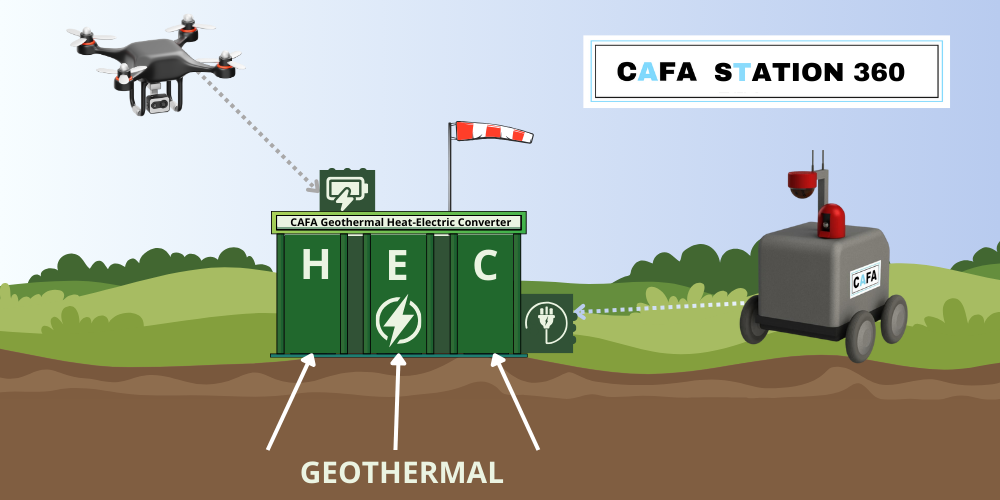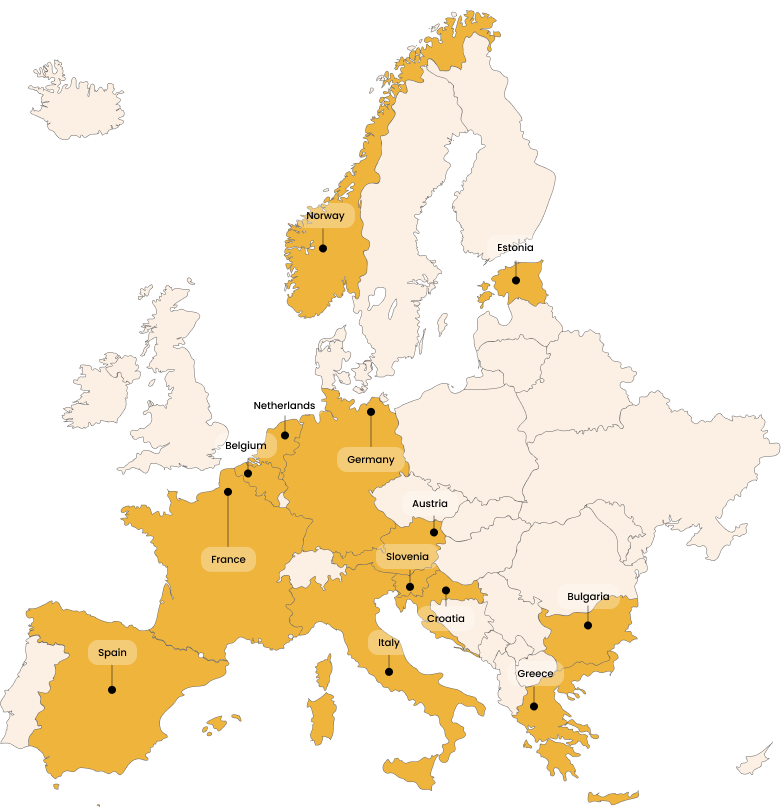Geo-HEC Charging Station for mobile robots and drones
Electricity is produced by CAFA Geothermal Heat to Electric Converter (Geo-HEC) system
Which renewable energy source can be used for robots?
The modern society is rapidly evolving towards a direction where many activities and operations are uncrewed, occurring without direct human intervention or control. Examples such as:
- Uncrewed Ground Vehicles (UGVs),
- Uncrewed Aerial Vehicles (UAVs),
- Uncrewed Surface Vessels (USVs) etc.,
all point to a clear shift: moving from traditional human-led processes to technology-driven autonomous solutions, which require more and more electricity.
With this evolution, there is an inevitable need to ensure electrical power supply to sensors and other IoT devices, which are integral to robot work operations, forming a complete ecosystem.

Comparison between solar, wind and geothermal energy
In response to global climate change, most nations have established a goal to transition away from fossil fuels over the next three decades. Consequently, it is crucial to identify alternative energy sources that are environmentally friendly. Globally, the most prevalent renewable energy sources include solar, wind, geothermal, hydro, tidal. Since hydro and tidal energy are only available in limited locations, the three main renewable types available in each location – solar, geothermal, wind- are analyzed below.
Parameter | PV (solar) panel | Geothermal | Onshore wind generator |
Working hours per year (total 8760 h) | 1600 h | 7200 h | 2800 h |
Visual noise | Low visual noise | No | Strong visual noise |
Ground space (m2) required for 1MW | 8000 m2 | 1200 m2 | 5 000 m2 |
Frequency of maintenance
| Depending on the presence of dust, up to 2 times a week | Once a year maintenance. | Inspection and replacement of rotating parts. |
Heating and a cooling functionality | No | Yes, can be integrated with a heat pump system. | No |
Geo-HEC technology description
The CAFA Geo-HEC system generates energy from the temperature differences between the ambient air and the geothermal heat. CAFA Geo-HEC Station operates in all climate zones, regardless of location or time. The size of the site required for the Station depends on the desired output power (e.g. 10W to 1kW). Since the geothermal collection takes place underground, a relatively small site for the Station is required on the ground.
The upper limit of the efficiency of Geo-HEC system is determined by Carnot cycle, a theoretical ideal thermodynamic cycle (Sadi Carnot 1824). Carnot cycle max efficiency= 1- T2(cold)/T1(hot). For example, if T2 (cold from outdoor ambient air is -5 degrees Celsius (268 K) and geothermal heat is +40 Celsius (313 K), then 1- 268K/313K=0.85 i.e. 15%.
The system is scalable; therefore, it does not have to be 100W but, if necessary, the Geo-HEC system can consist of 10 modules (each 100W), which can be used to produce 1kW of electricity.
CAFA Geo-HEC Station value proposition
- Provides electricity for houses and cottages located in remote areas for approx. 7,200 hours a year. This is 5x more electricity production-hours per year than is provided by a PV solar panel.
- Provides 10W to 100W electricity to charge lawnmowers, UGVs and UAVs.
- Electricity for remote sensors and cameras and edge computing devices, designed for prolonged placement spanning months or years. About 1W to 10W of electricity is constantly needed by these devices – a demand that batteries cannot meet. There are 720 hours in one month, so with a consumption of 10W by the camera/computer, it is necessary to ensure batteries of 7200Wh, which means that it is necessary to change the batteries at least once a month.
- Electricity production from geothermal is CO2-free.
- Using on-site geothermal renewable energy for Uncrewed Vehicles means reducing the use of liquid fuels
- Reduces maintenance costs, as the Station is fully automated
- Ensures energy provision under harsh winter conditions as well as in very hot summer.


FUTURE ENERGY INDEPENDENT AND EFFICIENT DEPLOYABLE MILITARY CAMPS:
One of the first strategic projects
tackling green energy in the defence and security sector
STRATEGIC ROADMAP TOWARDS 2030-2050

CAFA TECH ROLE:
CAFA Tech contribution: Geo-HEC Station technology.CAFA leads also the Training and Documentation in the INDY project. We develop specialized training programs for stakeholders, focusing on military transfer assessments and bolstering the Critical Components Testing phase.